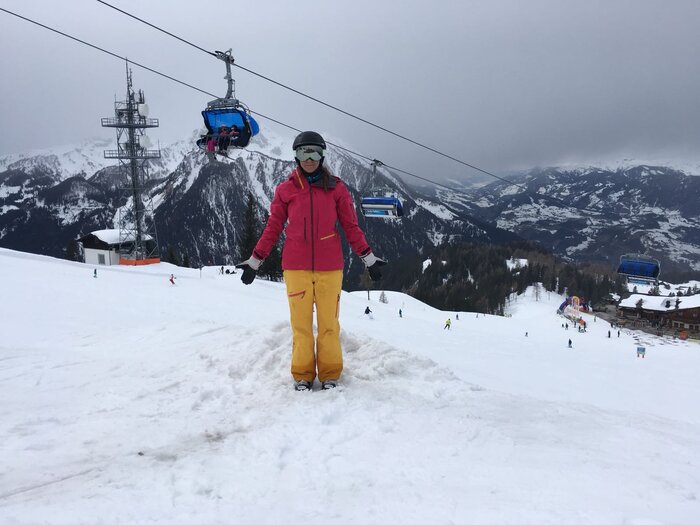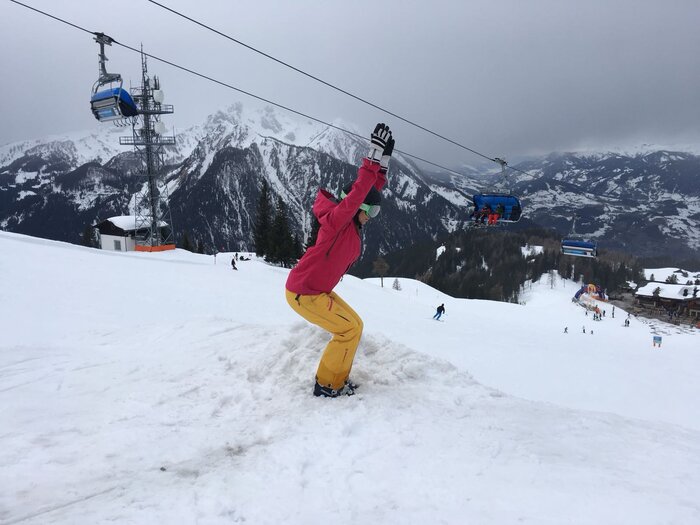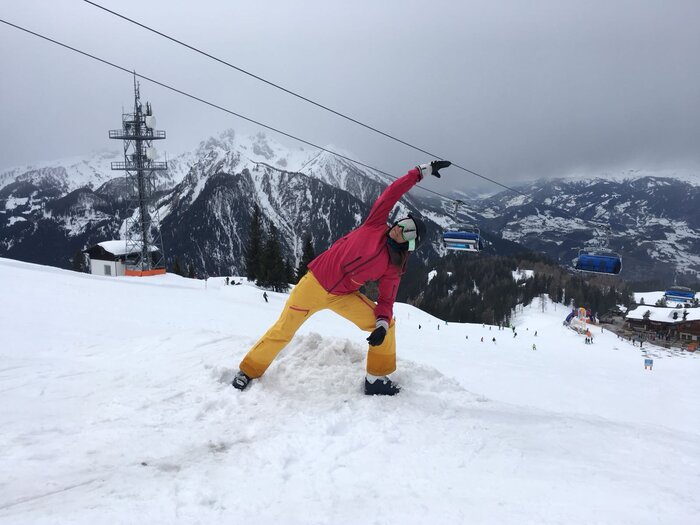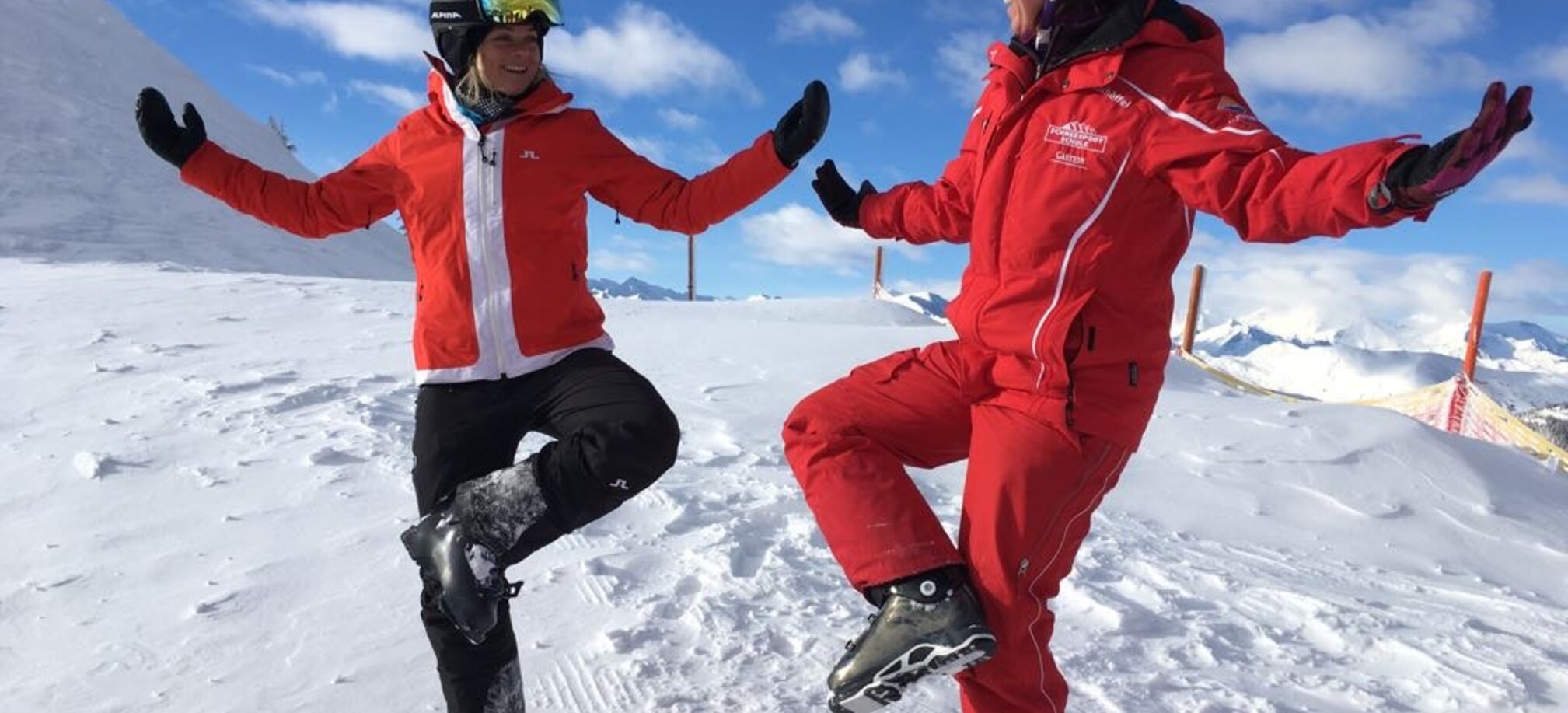
There could not be a more suitable name for a winter sports exercise: by doing the Mountain, one can effectively improve ones posture – as this yoga exercise stretches the spine and increases ones sense of balance. This can provide you with great stability on the run down! Let’s go:
- Stand up straight.
- Put your feet together, so that the balls of your feet and heels are slightly touching.
- Try to keep the outside edges of your feet as parallel as possible to each other.
- Lift your toes off the ground, spread them, and then starting with the little toe bring them back on to the ground.
- Now build up from the bottom to the top. When doing this, the weight is evenly spread on both the left and right foot, as well as on the balls of your feet and your heels.
- Pull the inner arch of your feet up, pushing you on to the outside edges of your feet.
- Your legs are active; the thighs are turned slightly inwards.
- Pushing your coccyx forwards and downwards will prevent a hollow back.
- The pelvis is pushed slightly forward and you can gently tense your buttocks.
- Pull your belly button back towards your spine.
- Roll your shoulders back once and let them fall back in a relaxed manner.
- Let your arms fall to your side. Your palms face your body but do not touch it.
- Your head should be straight and your chin should be parallel to the floor. This results in a line between the heels, the buttocks and the back of your head.
- The crown of your head should be stretched towards the ceiling, whilst looking straight ahead.
- If you feel that you are standing securely, then you can shut your eyes. This works on your balance even more.
- Take a few deep breaths and relax.
Additional great benefits: The Mountain position also strengthens thighs, knees and ankles and is anyhow good for the feet. This pleasant feeling is worth its weight in gold for both skiers and snowboarders. If you have a particularly difficult route planned, then do not worry: The Mountain position reduces stress and ensures quiet and concentrated breathing. It also heightens your mindfulness. Not a disadvantage if you want to head for some Après ski after skiing.

There is no time to sit down for a long while yet! So that you also have the necessary flexibility for slalom, strong calves are important. The so-called Chair helps with this. It is also good for strengthening the thighs and buttocks. And best of all: you further develop the flexibility of your ankles! This is how it works, step by step:
- Stand up straight with your feet hip width apart.
- Stretch your arms out in front with your palms facing down, the elbows are stretched out and the shoulders stay down.
- Bend your knees and tip your pelvis slightly back – just like you would sit on a chair. Keep your heels firmly on the ground.
- Keep a relaxed position. The palms face down to the floor and are parallel; your back is completely straight. Tip: Tense your stomach muscles!
- Breathe calmly and steadily. Close your eyes to concentrate better.
- Now, little by little, squat further down. Picture yourself on a comfortable chair, in which you sink ever further into. Attention: The knees should not stick out further than the tips of your toes.
- When you feel it is the right time, stand back up again keeping your back straight.
- Now relax: either sitting cross-legged or lying on your back.
Cool added value: To do this exercise, you do need a certain amount of strength in your thighs. However, the effort is definitely worth it: the exercise is unbelievably good for the knees and strengthens the muscles there directly. Of course, an effect of this exercise is also a strengthening of your posture, as the pelvis and spine are aligned. Moreover, the back, hips, ankles and of course the ligaments are trained by doing this. This is especially good for knee and ankle problems.
The Warrior is sometimes also called the Hero – either way, you need a lot of strength and stability for this yoga exercise. The result can certainly be seen in: stretched shoulders, neck, back muscles, but your stomach and groin will also be thankful. This is how it works:
- Here we start again in the Mountain position from exercise 1.
- Breathe out and place the feet shoulder width apart, stretch the arms parallel and upwards.
- Put the left foot forward and place the back one at a 45°- 60° angle to the right. Keep the left and the right heel in a straight line.
- Hips and shoulders face the front.
- Breathe in and bring your out-stretched parallel arms upwards again, keeping your shoulders wide.
- Your palms are turned facing inwards and consciously keep your shoulders down.
- Breathe out and bend the front leg so that the knee is over the heel.
- Play about a bit with your weight balance and find the ideal stability.
- Tip your head slightly back and look at your hands.
- Calmly breathe in and out. Remain in this position for 30 seconds.
- Then relax the arms by your body. And repeat on the other side.
Your advantage on the slopes: with the Warrior, you not only strengthen your arms, shoulders and chest, but also your lungs. In addition, it makes your hips more flexible! This is needed for the well-known sleek ski movement. Furthermore, the yoga exercise also trains endurance and power and improves attentiveness and balance. Last but not least, it also stimulates the digestive organs – and this can certainly help those of you after too much Après ski.

Hence, yoga is precisely so brilliant as it can provide the essential balance and focus that you need on the slopes. Whether a skiing or snowboarding enthusiast – with this exercise you train your leg power and coordination. You strengthen your torso and protect your spine, which gives you secure stability. Flexibility is now on your side. Why not give it a go!
Discover Package: Reload in Dorfgastein
Wolfgang Fuchs committedly manages the Austrian company Lotuscrafts – the specialist for high quality meditation and yoga accessories. Mindfulness and quality portray the ecological products of Lotuscrafts.
